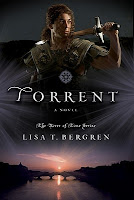Today the awesome Kathleen Peacock, author of the amazing novel Hemlock is stopping by with her guest post on the princess from The Paper Bag Princess. I love this post and hopefully you'll enjoy it as much as I did.
If you want to check out The Paper Bag Princess, you can do so by visiting
Goodreads.
Be sure to visit Kathleen on her
website,
Facebook, and on
Twitter. Also be sure to add Hemlock to your own
Goodreads shelf.
------------------------------------------------------------------------------------------------------------
Princess, Save Thyself
“Elizabeth was a beautiful princess. She lived in a castle and had expensive princess clothes. She was going to marry a prince named Ronald.” – The Paper Bag Princess, by Robert Munsch (illustrated by Michael Martchenko)
If damsels are supposed to be in distress, no one sent Elizabeth the memo. After a dragon destroys her castle and kidnaps her fiancé, Elizabeth does the only sensible thing: she dons a paper bag—the one thing the dragon didn't burn to a crisp—and heads off to rescue her betrothed.
She doesn't call someone stronger or bigger. She doesn't cry at the enormity of the task in front of her or wait to see if her handsome prince can escape the dragon on his own. Elizabeth, to borrow a phrase from Nike, decides to “just do it” and fix things herself.
She follows the dragon’s trail, finds its lair, and in a stroke of genius, tricks the dragon into exhausting both its fire and strength.
She does it without help or praise.
She does it in spite of the fact that her castle has been destroyed and her princess clothes have been burned to ashes and the dragon normally finds princesses quite tasty.
Elizabeth is, to put it bluntly, the kind of princess every little girl deserves. She’s smart, courageous, and resourceful, and the thought that she might not be able to best dragons never occurs to her.
Munsch could have stopped there. He could have fixed himself a turkey sandwich and sat back, content in the knowledge that he had done a great job.
But he didn't.
No, he went on to give us a princess who knew her own worth.
When Elizabeth finally frees her beloved, he doesn't thank her. He doesn't show a speck of gratitude or affection. Instead, he tears her appearance to shreds and tells her to come back when she looks like a real princess.
Elizabeth doesn't cry or lose her temper or wonder if he’s right. For the first time, she sees Prince Ronald as he truly is and realizes that she doesn't like him very much. Ronald looks like a prince but acts like a bum and Elizabeth doesn't hesitate to tell him so.
The very last line of The Paper Bag Princess is “They didn't get married after all” and it’s accompanied by a joyous illustration by Michael Martchenko of a jubilant Elizabeth skipping off into the sunset, happy and on her own. The image is so iconic that Canadian publisher Annick Press uses Elizabeth’s skipping silhouette as part of their logo.
That last line and its accompanying illustration is, to me, is what makes The Paper Bag Princess one of the most important books in children’s literature.
In Elizabeth, Robert Munsch and Michael Martchenko gave us a princess who is smart enough to realize that sometimes happily ever after means being happy on your own—at least for awhile. It’s a lesson most people take years to learn, if they learn it at all, and it’s why, thirty-three years after she stepped into the limelight, Elizabeth is still my kind of princess.
------------------------------------------------------------------------------------------------------------
About Kathleen
Kathleen spent her childhood fighting imaginary dragons, commanding make-believe armies, and piloting invisible spaceships. She writes young adult urban fantasy, including the Hemlock Trilogy (available from Katherine Tegen Books/HarperCollins). She once saw Robert Munsch but was too shy to talk to him.




















.jpg)











